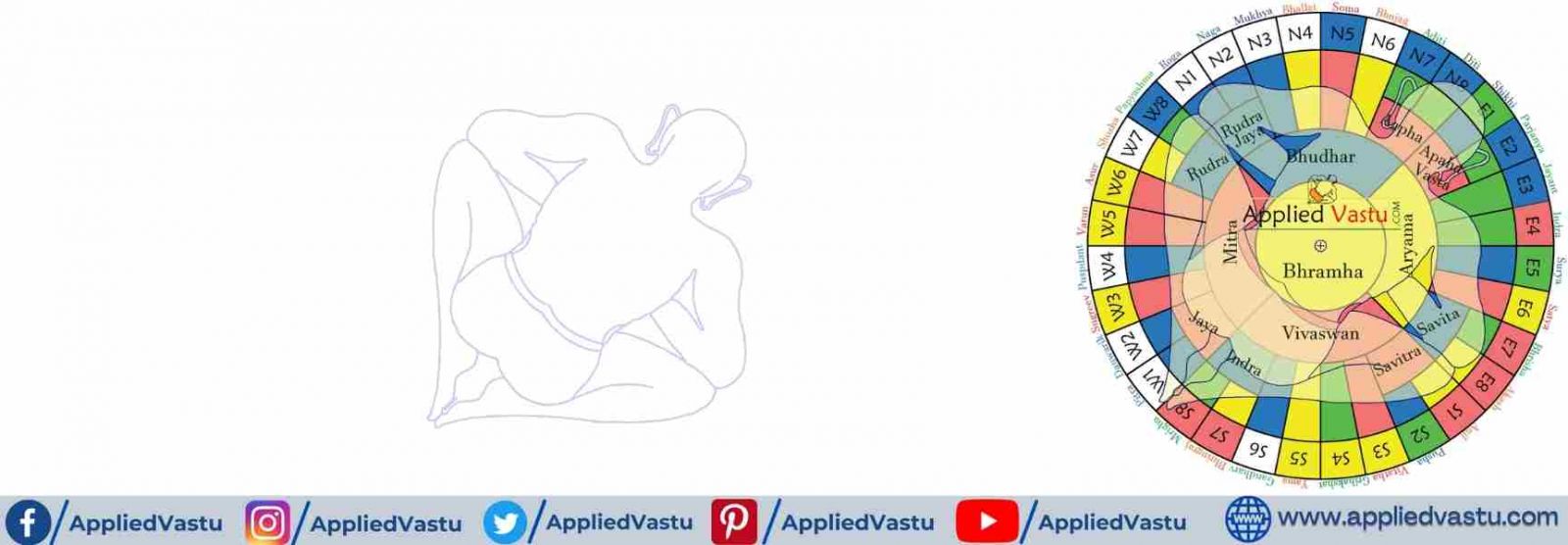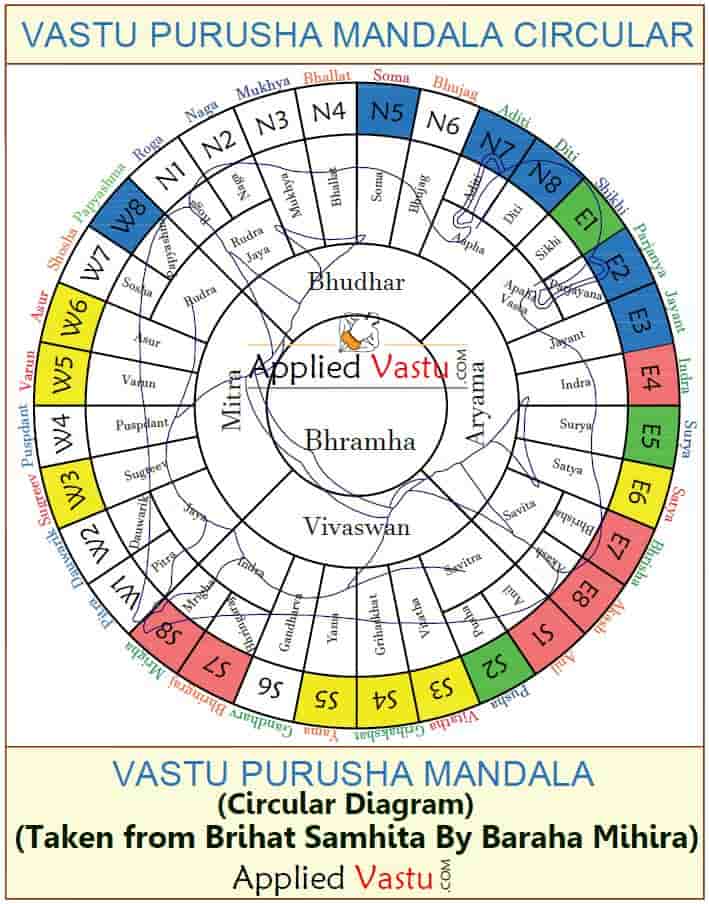
Vastu Purusha Mandala and 45 energy fields
Know all about Vastu Purusha Mandala architecture
Vastu Shastra contains a vast subject of the traditional Indian system of architecture that controls our mind, life, and fate. It follows the discipline of construction as per the laws of nature and its elements. However, we often wonder about the fascinating origin of vastu shastra (i.e., when and how did it emerge?). Let's return to the pre-historic era, where it all began with the emergence of the Vastu Purusha Mandala. Vastu purush Mandal is the core philosophy of ancient Indian architectural planning.

Book Your Personalized Site Visit and Astro-Vastu Consultation by AppliedVastu® Get expert guidance directly from Principal Consultants Apurba Das and Shouvik Das — available in your city and across India (and globally). Contact us now to secure your appointment!
- ✔️ Personalized Consultation
- ✔️ Directly By Principal Consultant
- * Home * Office * Business * Factory *
In this article, we will discuss in detail many unknown facts of vastu Purusha Mandal. Such as the history of the origin of the vastu purush, the structure of the vastu Purusha Mandal, the 45 vastu deities, the essence, the importance of the Vaastu Purush Mandala.
The Origin or birth story of Vastu Purusha
According to Hindu Mythology, there was a fierce war between Devtas (God) and Asuras (Demons). Lord Shiva stood for Devtas. During the war with Andhakasur, some drops of his sweat fell on the earth from Shiva's head. From this drop of sweat, a gigantic being took birth. This enormous being is known as Vastu Purusha. The vast giant claimed himself as Lord Shiva's son and got permission to eat 'Triloka' (because of his excessive hunger) from Lord Shiva. As soon as the giant started eating Trilok, the gods became frightened and resorted to Brahma to save the world.
So, with the help of Astha Dikapalakas (the guardian of 8 cardinal directions), Lord Brahma, to save Triloka, ordered other Devtas and Asuras to pin him down on the earth with his head towards the northeast and feet towards the southwest. Brahma occupied the central part of Vastu Purusha, and the other 44 deities (45 energy fields) who represent the various aspects of our life possessed the different parts of his body. Brahma then blesses the Vastu Purusha that whenever a structure is built on earth (as compensation), that structure will become your food if you do not worship at that time. So, there is a belief, if you perform this ritual whenever you build any structure on a vacant plot, you will be blessed by Devtas, but if you don't serve this ritual, you may fall into the rage of Asuras, better prepare to welcome in sorrow in life.
What does Vastu Purusha Mandala symbolize?
The significance of the Vastu Purusha Mandala
'Vastu Shastra' is based on the theory that the earth is a human being throbbing full of energy and life. Vastu Purusha Mandala symbolizes this human being or cosmic man, and we explain the theories with the help of a diagram or chart called Vastu Purusha Mandala (chart). Every minute detail related to any single structure or construction on earth is based on the principles of Vastu Purusha Mandala architecture. It starts from digging a vacant plot to the completion of the building- Brahma and the 44 deities ( Total 45 deities ) known as energy fields slowly occupy their determined places with the development of the structure. So, we can see that Vastu Purusha Mandala is the core of vastu design for temples, houses, offices, and factories for ages.
The Structure of Vastu Purusha Mandala: 45 energy fields
However, the Vastu Purusha Mandala is not just a giant picture encased in many cells and squares. As previously said, it shows the intersection and the energy currents that flow in the human body. According to vastu shastra, we know this energy current profoundly impacts our mind, body, and soul. After the completion of the building, the inhabitants living there can experience the effect. The above diagram is depicted in the square in a 360-degree chart format. The diagram is divided into 9*9=81 parts or squares. In this diagram, we find Brahma in the central part known as Brahmasthan and 44 deities in their determined places. Here among 45 deities, 32 gods are shown in the external closures and 13 deities in the internal closures. They rule various aspects of our life according to their inherent qualities. The core theory of any vastu planning & design stands above Vastu Purusha Mandala. The room of the house has to be plan according to the characteristics of each energy field among 45 deities located on the Vastu Purusha Mandala. Vastu Purusha Mandala with 8*8=64 squares, called Manduka/Chandita Mandala. However, the diagram which shows 9*9=81 courts is called Paramasaayika Mandala. These two 9*9 and 8*8 grids are mainly popular among vastu practitioners. The Vastu professionals used Paramasaayika Mandala to design homes, palaces and the Manduka mandala to design temples.
A summary of 4 Vithi- Brahma Vithi, Deva Vithi, Manushya Vithi, Paishacha Vithi, and an Explanation of all 45 Deities
Brahma Vithi
The center of any vastu is considered the most sacred part of the building. But do you know? In Vastu Purusha Mandala, this place is also known as Brahma Vithi. The center of the vastu Purusha mandala is called Brahmasthan, the place of Lord Brahma. After Shilanyas, when the construction of the foundation wall reaches the plinth level, this sacred energy field originates-Brahma occupies his place. It is believed that this divine energy field of Brahma is responsible for the creation and existence of everything in the universe. It is believed that this divine energy field of Brahma handles the creation and existence of everything in the universe. So, according to vastu shastra, you should never mess with this place.
Deva Vithi
With the progress of construction, when the raising of the wall reaches a height of 5-8 feet, the energy field of Brahma expands in four directions in the Vastu Purusha Mandala. These four directions are occupied by 4 Devtas (out of 12 Adityas mentioned in Bhagavata Puran). These 4 Devtas also symbolize the four heads of Brahma. They carry forward the process of creation. Let's have a look at their responsibility in Vastu Purusha Mandala :
Bhudhar: Bhudhar offers the power of manifestation of self.
Aryama: Aryama offers the power to establish a new connection.
Vivaswaan: Vivaswaan offers the energy to gain success or fame in life.
Mitra: Mitra gives you the power of inspiration.
Manushya Vithi
After raising the wall more (the casting of the roof is remaining), the energy fields expand in four diagonal directions (i.e., northeast, southeast, southwest, northwest). Now the energy fields extend themselves more to the outer part of the Vastu Purusha Mandala diagram. We can see this in each of these directions. Two energy fields take birth. For example, if we draw a line to divide the northeast from southwest and northeast from the southeast, we can see a single energy field takes shape and forms on each side of this dividing line. Let's have a look at the responsibility of these energy fields in Vastu Purusha Mandala :
North East
Apaha: This energy field spreads the energies of healing.
Apahavatsa: Apahavatsa is the carrier of the healing power generated by Apaha to its inhabitants.
South East
Savita: This energy field offers energies to motivate any action.
Sosa/Savitra: This energy field gives you the energy to continue those actions.
South West
Indra: This energy field is highly beneficial for business, enhancing business properties' growth.
Indrajaya: This energy is a channel through which you can achieve the growth or prosperity of business.
North West
Rudra: This energy field helps carry out tasks without interruption and ensures the flow of activities in life.
Rudrajaya: This energy field provides supportive energy to carry out ideas and also stabilize the mind.
Paishacha Vithi
Now we come to the outer part of the periphery, where we can see 32 deities or energy fields develop and take place in a concentric pattern. Once the casting of the roof is completed, in each of the diagonal directions, four energy fields form. In this process, we get 16 energy fields that take shape in diagonal directions.
North East
Aditi: Aditi is the mother of Gods (Devtas), so this energy field in the Vastu Purusha Mandala gives you security.
Diti: Diti is the mother of Asuras (Demons). She widens our vision and helps us to see the actual truth of life.
Shikhi: From this energy field, you get the power of ideas and attain the ability to project your thought to the world.
Parjanya: Parjanya is the giver of rain. So, this energy field blesses its inhabitants with fertility and makes their wishes come true.
South East
Brisha: This energy field is known to motivate any thinking or activity.
Akash: Akash symbolizes space, so this energy field offers you the space for manifestation.
Anil: Anil symbolizes air. So, this energy field helps to uplift the fire in your soul to start any action further.
Pusha: Pusha blocks the path of enemies.
South West
Bhringraj: This energy field extracts the proper nutrient from food and removes wastage of food.
Mrigah: This energy field initiates curiosity in you, needed to attain any skill.
Pitra: Pitra, our ancestors, provides us with safety and happiness in life.
Dauwarik: Dauwarik represents Lord Shiva's vehicle Nandi (known for wide knowledge). So, this energy field makes its inhabitants highly knowledgeable and genius.
North West
Shosha: Shosha provides detoxification from negative emotions.
Papyakshama: This inauspicious energy field does not do any good to you, as it gives you addiction, diseases, and the feeling of guilt in life.
Roga: This energy field offers you the needed support in life.
Naga: Naga initiates craving in you, also provides emotional enjoyment. Now, let's look at the 16 more energy fields which form in the four cardinal directions after the construction of the superstructure (though all the construction work is done, the installation service of plumbing, electrical connections is remaining).
East
Jayant: This energy field refreshes your mind and body and also provides victory.
Mahendra: Mahendra or Lord Indra helps to establish a connection with others and provides you with administrative power.
Surya: Surya is known as the core controller. This energy field gives you a healthy life, fame, and power.
Satya: Satya initiates authenticity and credibility in you and ensures your status in society.
South
Vitara: This energy field represents falsehood and pretension and causes sorrow and depression in life.
Gurhakshat: Gurhakshat binds the mind to the limit.
Yama: This energy field binds the universe in law and order.
Gandharva: Gandharvas are known for their art and music. So, this energy field rules all kinds of art and music.
West
Sugreev: This energy field makes its inhabitants the receiver of knowledge.
Pushpadant: Pushpadant is the granter of fulfilling all desires.
Varun: It is believed that Varun, the lord of the sea, blesses its inhabitants with immortality.
Asur: The responsibility of the Asur energy field is to release the mind from temptation.
North
Mukhya: Mukhya, another name of Lord Vishwakarma, defines the principal purpose of the construction and helps to start it into action.
Bhallat: This energy field is the granter of huge abundance in life.
Soma: This is the place of Lord Kubera. We know Kubera is the lord of wealth. This energy field ensures money and opportunities in life.
Bhujag: Bhujag is the lord of hidden treasures. So, this energy field, also known as the preserver of medicines, secures the health of the occupants.
Marmasthana: Vital Points of Mandala
While a vastu architect plans the entire property layout, it is essential to respect Marmasthana's energy point. Marma or Maha marma in vastu is the vital energy coordinates on the vastu purush Mandal diagram, which we should not hurt by pillars, nails, or any heavy structure. According to Brihat Samhita, there are nine maha Marmasthanas. The intersection of the six diagonals (as mentioned in the picture ) calculates vastu marma points.
In Vastu Soukhyam and Samrangangan Sutradhara, these diagonals are known as Vanshas. The diagonal extends between the following cells-from Shikhi to Pitra, Aditi to Sugriv, Jayant to Bhringraj, Roga to Anil, Mukhya to Bhrisha, Sosha to Vitath. Maha marma is the point where the directional crosses each other.
The head, mouth, heart, navel, anus, and nipples are the six significant parts of Vastu Purusha, just as a human being. We should never hurt these sensitive points in any manner. The horizontal, vertical, and diagonal lines we draw inside the mandala are the veins of Vastu Purusha through which the cosmic energies flow, make the plot a living entity.
We must not make any pillars, walls, doors, windows upon these points. As previously said, Vastu Purusha is considered a human being. So, according to vastu shastra, if we hurt the marma points of vastu purush mandala by a marma vastu vedha, it may cause severe vastu defects for that structure.
Application and Importance of Vastu Purusha Mandala in Subject like 'Vastu Shastra'
What is the principal aim of vastu shastra? It is based upon the importance of sunlight, airflow, magnetic flux, and earth energies on humans. The chief objective of vastu shastra is to offer the inmates of the house maximum positive energy from everything to lead a healthy and stress-free life. The Vastu Purusha Mandal is not only a graphical presentation of 45 energy fields. It is the distribution of vastu energy that directly interacts with our subconscious mind.
Vastu Mandala grid exists all single pieces of property. It may be a plot, home, office, or factory 45 energy grids present everywhere. So before preparing any layouts for new construction or analyze any existing property, the casting of vastu Purusha mandala is mandatory. Each part of any building is designed according to the Vastu Purusha Mandala diagram, as every energy field has specific characteristics. However, it is impossible to follow all the rules mentioned in Vastu Purusha Mandala guidelines today, as most of us live in flats. But to get the best results, we should consult with a good vastu practitioner.
FAQ
Q1. Is Vastu Purusha Mandala necessary for each vastu analysis?
Answer: Vastu Purusha Mandala is the core philosophy of every vastu space. It is essential for every vastu analysis (i.e., house, flat, office, factory). Design the vastu Purusha mandala diagram first, and then you can proceed with your plan. You should never proceed with design and planning without Vaastu Purusha Mandal.
Q2. How to consider Vastu Purusha Mandala for a flat or apartment?
Answer: Most people are often confused in that case. For example, a floor has four flats. So, the people usually consider the entire floor to calculate Vastu Purusha Mandala. But according to vastu shastra, it is wrong. Consider only your flat to calculate the Vastu Mandala grid.
Q3. How to draw Vastu Purusha Mandala for irregular and diagonal plots?
Answer: You can draw Vastu Chakra using the polar or angular division method for irregular and diagonal plots. AutoCAD is the best drafting software for drawing vastu grids accurately.
Q4. What is the head direction for Vastu Purush in the southern hemisphere?
Answer: The head direction for Vastu Purusha in the southern hemisphere towards the southeast is equivalent to the Vastu Purusha's head directly towards the northeast direction in the northern hemisphere.
Conclusion :
So, in a nutshell, we can tell that Vastu Purusha Mandala is the universal equation, and it is essential for every vastu calculation. The casting of the vastu mandala grid is a mandatory step before any vastu design. The vastu experts of Applied Vastu.Com always keep in mind the eternal rules of Vastu Purusha Mandala to design any structure to ensure peace, health, and prosperity in life. They help you correct any existing vastu without demolition with their unique guidance.













